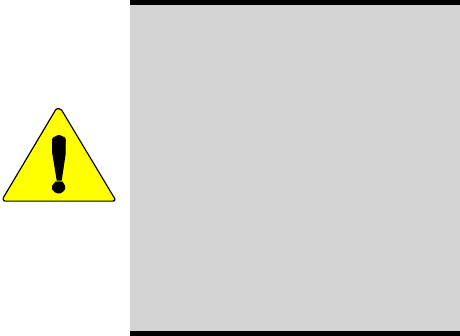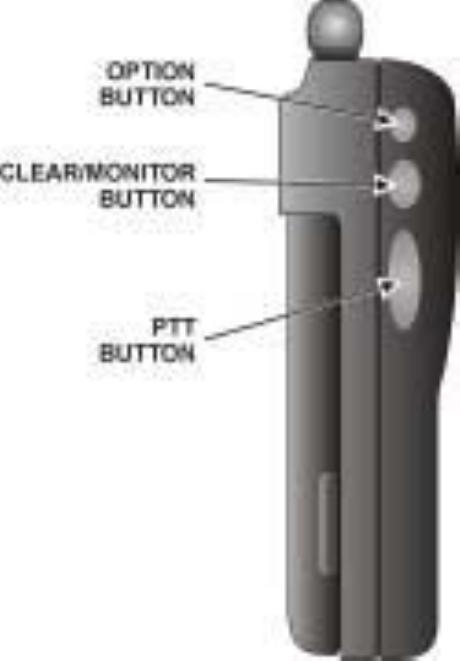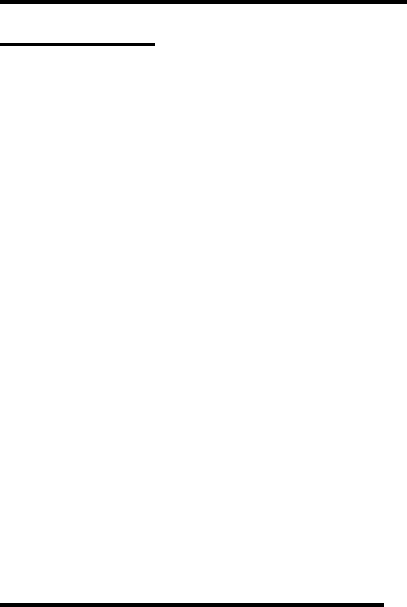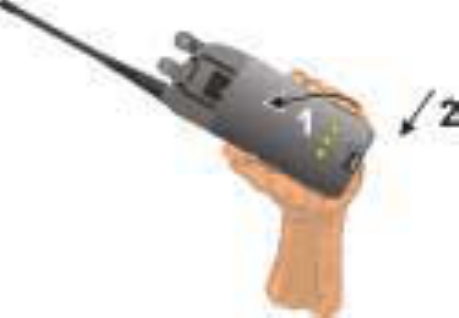Manual

MM101027V1 R1A
Operator’s Manual
PANTHER
300P
Portable Radio

2
TABLE OF CONTENTS
Page
SAFETY TRAINING
INFORMATION ................. 3
SAFE PRACTICE
INFORMATION ................. 8
OPERATING RULES AND
REGULATIONS................. 12
INTRODUCTION ............... 17
CONTROLS AND
INDICATORS .................... 18
PANTHER 300P RADIO
INDICATORS .................... 23
BASIC OPERATION.......... 25
SELECTIVE SIGNALING... 28
PROGRAMMABLE PTT
FUNCTIONS ..................... 31
CLONING.......................... 33
BATTERY OPERATION .... 34
The software contained in this device is
copyrighted by Com-Net Ericsson Critical
Radio Systems, Inc. Unpublished rights are
reserved under the copyright laws of the
United States.
NOTICE!
This manual is published by Com-Net Ericsson Critical
Radio Systems, Inc., without any warranty.
Improvements and changes to this manual necessitated
by typographical errors, inaccuracies of current
information, or improvements to programs and/or
equipment, may be made by Com-Net Ericsson Critical
Radio Systems, Inc., at any time and without notice.
Such changes will be incorporated into new editions of
this manual. No part of this manual may be reproduced or
transmitted in any form or by any means, electronic or
mechanical, including photocopying and recording, for
any purpose, without the express written permission of by
Com-Net Ericsson Critical Radio Systems, Inc.
Copyright © 2000 Com-Net Ericsson Critical Radio
Systems, Inc. All rights reserved.

3
SAFETY TRAINING
INFORMATION
Your Com-Net
Ericsson radio
generates RF
electromagnetic
energy during
transmit mode. This radio is
designed for and classified as
“Occupational Use Only”
meaning it must be used only
during the course of
employment by individuals
aware of the hazards and the
ways to minimize such hazards.
This radio is NOT intended for
use by the “General Population”
in an uncontrolled environment.
This radio has been tested and
complies with the FCC RF
exposure limits for “Occupational
Use Only.” In addition, your Com-
Net Ericsson radio complies with
the following Standards and
Guidelines with regard to RF
energy and electromagnetic energy
levels and evaluation of such levels
for exposure to humans:
WARNING

4
• FCC OET Bulletin 65 Edition
97-01 Supplement C,
Evaluating Compliance with
FCC Guidelines for Human
Exposure to Radio Frequency
Electromagnetic Fields.
• American National Standards
Institute (C95.1 – 1992), IEEE
Standard for Safety Levels
with Respect to Human
Exposure to Radio Frequency
Electromagnetic Fields, 3 kHz
to 300 GHz.
• American National Standards
Institute (C95.3 – 1992), IEEE
Recommended Practice for
the Measurement of
Potentially Hazardous
Electromagnetic Fields – RF
and Microwave.
CAUTION
To ensure that your
exposure to RF
electromagnetic
energy is within the
FCC allowable limits
for occupational
use, always adhere
to the following
guidelines:
5
• DO NOT operate the radio
without a proper antenna
attached, as this may damage
the radio and may also cause
you to exceed FCC RF
exposure limits. A proper
antenna is the antenna
supplied with this radio by
Com-Net Ericsson or an
antenna specifically
authorized by Com-Net
Ericsson for use with this
radio.
• DO NOT transmit for more
than 50% of total radio use
time (“50% duty cycle”).
Transmitting more than 50%
of the time can cause FCC RF
exposure compliance
requirements to be exceeded.
The radio is transmitting when
the “TX” LED on top of the
radio is lit. You can cause the
radio to transmit by pressing
the “PTT” button.
• ALWAYS use Com-Net
Ericsson authorized
accessories (antennas,
batteries, belt clips,
speaker/mics, etc). Use of
unauthorized accessories
may cause the FCC
Occupational/ Controlled
Exposure RF compliance
requirements to be exceeded.
6
• ALWAYS keep the device and
its antenna at least 2.0 cm
(0.8 inch) away from the body
and 5 cm (2 inches) from the
face when transmitting to
ensure FCC RF exposure
compliance requirements are
not exceeded. This radio has
been tested for RF exposure
compliance at a distance of
1.3 cm from the body and 4.0
cm from the face for a worse
case scenario. However, to
provide the recipients of your
transmission the best sound
quality, hold the antenna at
least 5 cm (2 inches) from
mouth, and slightly off to one
side.
The information listed above
provides the user with the
information needed to make him or
her aware of a RF exposure, and
what to do to assure that this radio
operates within the FCC RF
exposure limits of this radio.
7
Electromagnetic
Interference/Compatibility
During transmissions, your Com-
Net Ericsson radio generates RF
energy that can possibly cause
interference with other devices or
systems. To avoid such
interference, turn off the radio in
areas where signs are posted to do
so. DO NOT operate the
transmitter in areas that are
sensitive to electromagnetic
radiation such as hospitals, aircraft,
and blasting sites.
8
SAFE PRACTICE
INFORMATION
The operator of any land mobile
radio should be aware of certain
hazards common to the operation
of radio transmitters. A list of
several possible hazards is
given:
1. Explosive Atmospheres -
Areas with potentially
explosive atmosphere are
often, but not always, clearly
marked. These may be fueling
areas, such as gas stations,
fuel or chemical transfer or
storage facilities, and areas
where the air contains
chemicals or particles, such
as grain, dust, or metal
powders. Sparks in such
areas could cause an
explosion or fire resulting in
bodily injury or even death.
Turn OFF your radio when
in any area with a
potentially explosive
atmosphere. It is rare, but
not impossible that the
radio or its accessories
could generate sparks.
9
2. Electronics Systems - RF
energy from your portable
radio may affect some
electronic equipment. Most
modern electronic equipment
in cars, hospitals, homes, etc.
are shielded from RF energy.
However, in areas that
instruct you to turn off two-
way radio equipment, always
observe the rules. If in
doubt, power the radio OFF.
3. Dynamite Blasting Caps -
Dynamite blasting caps may
be caused to explode by
operating a radio within 500
feet of the blasting caps.
Always obey the "Turn Off
Two-Way Radios" signs
posted where dynamite is
being used.
When transporting blasting
caps in your vehicle:
• Carry the blasting caps in
a closed metal box with a
soft lining.
• Leave the radio OFF
whenever the blasting
caps are being put into or
removed from the
vehicle.
4. Radio Frequency Energy -
Do not use a radio with a
10
damaged or missing antenna.
A minor burn may result if a
damaged antenna comes into
contact with the skin.
Replace a damaged antenna
immediately. A missing
antenna could damage your
radio. Use only the supplied
or approved antenna.
Unauthorized antennas,
modifications, or attachments
could damage the radio unit
and may violate FCC
regulations.
Always turn off your portable
radio before boarding any
aircraft. Use it on the ground
only with crew permission.
Do not use it in the air.
5. Safe Driving
Recommendations -
(Recommended by AAA)
Read the literature on the safe
operation of the radio.
Keep both hands on the
steering wheel and the radio
secured whenever the vehicle
is in motion.
Place calls only when vehicle
is stopped.
11
• When talking from a
moving vehicle is
unavoidable, drive in the
slower lane. Keep
conversations brief.
• If a conversation requires
taking notes or complex
thought, stop the vehicle
in a safe place and
continue the call.
• Whenever using a radio,
exercise caution.
12
OPERATING RULES AND
REGULATIONS
Two-way FM radio systems must
be operated in accordance with the
rules and regulations of the local,
regional, or national government.
In the United States, the
PANTHER 300P portable radio
must be operated in accordance
with the rules and regulations of
the Federal Communications
Commission (FCC). As an operator
of two-way radio equipment, you
must be thoroughly familiar with the
rules that apply to your particular
type of radio operation. Following
these rules helps eliminate
confusion, assures the most
efficient use of the existing radio
channels, and results in a smoothly
functioning radio network. When
using your two-way radio,
remember these rules:
1. It is a violation of FCC rules to
interrupt any distress or
emergency message. As your
radio operates in much the
same way as a telephone
"party line", always listen to
make sure that the channel is
clear before transmitting.
Emergency calls have priority
over all other messages. If
someone is sending an
13
emergency message - such
as reporting a fire or asking
for help in an accident - KEEP
OFF THE AIR!
2. The use of profane or
obscene language is
prohibited by Federal law.
3. It is against the law to send
false call letters or false
distress or emergency
messages. The FCC requires
that you keep conversations
brief and confine them to
business. To save time, use
coded messages whenever
possible.
4. Using your radio to send
personal messages (except in
an emergency) is a violation
of FCC rules. You may send
only those messages that are
essential for the operation of
your business.
5. It is against Federal law to
repeat or otherwise make
known anything you overhear
on your radio. Conversations
between others sharing your
channel must be regarded as
confidential.
6. The FCC requires that you
identify yourself at certain
specific times by means of
your call letters. Refer to the

14
rules that apply to your
particular type of operation for
the proper procedure.
7. No changes or adjustments
shall be made to the
equipment except by an
authorized or certified
electronic technician.
Under U.S. law, operation of an
unlicensed radio transmitter
within the jurisdiction of the
United States may be
punishable by a fine of up to
$10,000, imprisonment for up to
two years, or both.
IMPORTANT
15
OPERATING TIPS
Antenna location and condition is
important when operating a
portable radio. Operating the radio
in low areas or terrain, under power
lines or bridges, inside of a vehicle
or in a metal or steel framed
building can severely reduce the
range of the unit. Mountains and
buildings can also reduce the
range of the unit.
In areas where transmission or
reception is poor, some
improvement may be obtained by
ensuring that the antenna is
vertical. Moving a few yards in
another direction or moving to a
higher elevation may also improve
communications. Vehicular
operation can be aided with the
use of an externally mounted
antenna.
Battery condition is another
important factor in the trouble free
operation of a portable radio.
Always use properly charged
batteries.
16
For efficient radio operation, hold
the front of the portable radio
approximately two inches from your
mouth and speak into the
microphone at a normal voice level.
Keep the antenna in a vertical
position when receiving or
transmitting a message. Do not
hold the antenna when receiving a
message and, especially, do not
hold it when transmitting a
message.
17
INTRODUCTION
This manual describes the
operation of the Com-Net Ericsson
PANTHER™ 300P portable radio.
The PANTHER 300P portable radio
is a high performance FM portable
radio providing reliable two-way
communication in a Conventional
Radio System.
The PANTHER 300P portable radio
can be programmed with up to six
channels. The PANTHER 300P
portable radio operates on any of
the following Conventional
platforms:
• Channel Guard
Encode/Decode
[Squelch Tail Elimination
(STE) optional]
• Digital Channel Guard
Encode/Decode
• Type 99 Decode

18
CONTROLS AND
INDICATORS
Figure 1 – Panther 300P Radio
Top View

19
Figure 2 – PANTHER 300P Radio
Side View
Monitor/Clear Button
Function
This section describes the
functionality of Monitor/Clear
button.

20
Monitor/Clear
The Monitor/Clear function
monitors the channel for activity.
While the Monitor/Clear is
pressed, squelch, the Channel
Guard decoder, and the Type 99
decoder are disabled.
If the channel is clear, squelch
noise will be heard. If the channel
is busy, traffic will be heard.
When the Monitor/Clear button is
released, squelch, Channel Guard,
and Type 99 are re-enabled.
After a successful Type 99 decode,
press the Monitor/Clear button to
switch the Type 99 Decoder state
from Monitor mode to Selective
Call mode.
Option Button Functions
The following functions can be
assigned to the Option button.
NOTE
Press and hold the
Option button to
execute the program-
med function.

21
Table 1: Programmed Functions
States
Function 1 Short
High
Tone
2 Short
High
Tones
High/Low
Power
High
Power
Low
Power
Local/Dista
nt Squelch
Local Distant
Type 99 ON OFF
Disabled
No function is assigned to the
Option button. When pressed, the
radio will emit a Denied Alert Tone.
High/Low Power
The High/Low Power function
toggles the transmitter power
between “High” and “Low”. “High”
power is the longer-range setting.
”Low" power is the battery-life
conserving setting.
Local/Distant Squelch
The Local/Distant Squelch function
toggles the channel squelch setting
between “Local” and “Distant”.
“Local” squelch reduces the
number of received degraded
transmissions. ”Distant" squelch

22
increases the number of received
transmissions.
Type 99 ON/OFF
The Type 99 function toggles the
state of the Type 99 Decoder
between “ON” and “OFF”. Type 99
mutes receive audio until a valid
Type 99 call is received. “ON”
indicates the radio is operating in
Selective Call mode. ”OFF"
indicates the radio is operating in
Monitor mode.
If an invalid or no Type 99 decode
is programmed on a channel, the
Type 99 function is programmed
for the Option button and the
Option button is pressed, the radio
will emit a Denied Alert Tone.

23
PANTHER 300P RADIO
INDICATORS
The Light Emitting Diode (LED)
and tones indicate the state of the
radio.
Table 2: Radio Indicators
LED Indicators: ●continuous ]flashing
Indicator Tones: High Mid Low
LED Tone Function
3 mid
tones
Power-up
complete
1 mid tone Low battery
continuou
s high
tone
Transmit timer
has expired1
continuou
s mid tone
Channel is
busy2 or
synthesizer
error
continuou
s low tone
Fatal error
1 short
mid tone
Action denied
The following features must be enabled
during programming to receive listed
indication:
1 CCT (Carrier Control Timer) – the radio
will emit this alert until the PTT button is
released.
2 TX Busy

24
LED Indicators: ●continuous ]flashing
Indicator Tones: High Mid Low
LED Tone Function
1 short
high tone
Programmed
function toggled
2 short
high tones
Programmed
function toggled
]green 1 short
tone
Receiving Type
99 Individual
Call
]green 2 short
tones
Receiving Type
99 Group Call
]green 3 short
tones
Receiving Type
99 Super
Group/Quick
Call
]red continuou
s mid tone
Battery too low
to transmit3
●red Transmitting
●green Receiving or
channel in use
]green Program mode
]amber Error or failure
]red
]green
Low battery
while operating
on a Type 99
channel
3 Multiple Low Battery Alerts – occurs after
PTT

25
BASIC OPERATION
Selecting A Channel
Rotate the Channel Knob
clockwise or counterclockwise until
the raised rib aligns with the
desired channel number.
Transmitting A Basic Call
1. Power ON the radio.
2. Select a channel.
3. Ensure there is no activity on
the channel by:
• checking the TX/RX
LED.
• pressing and holding the
Monitor/Clear button.
Squelch noise will be
heard if the channel is
clear of traffic.
4. Hold the radio approximately
2 inches from your mouth,
press the PTT button and
speak in the microphone.
NOTE
Speak in a normal
volume. Shouting will
degrade your
transmission.
5. Release the PTT button after
you have finished speaking.
26
Channel Guard
Channel Guard is a method of
reducing "channel chatter" by
equipping receivers with tone-
responsive devices, which only
allow calls with the correct sub-
audible tones to be heard by the
user. Channel Guard options and
parameters are defined in the radio
personality.
The radio can be programmed on a
per-channel basis to encode and/or
decode Channel Guard tones.
Squelch Tail Elimination (STE) can
be enabled or disabled on a
channel programmed with a
Channel Guard tone.

27
Channel Guard Monitor
Function
The radio can be programmed, on
a per-channel basis to transmit with
or without Channel Guard tones.
STE can optionally be enabled on
a per-channel basis.
Ensure there is no activity on the
channel by:
• checking the TX/RX LED.
• pressing and holding the
Monitor/Clear button.
Squelch noise will be heard if
the channel is clear of traffic.
Digital Channel Guard
Digital Channel Guard performs
similar to Channel Guard except
sub-audible codewords are
decoded and/or encoded. STE is
standard with Digital Channel
Guard operation.
28
SELECTIVE SIGNALING
Selective signaling controls the
muting and unmuting of the receive
audio. This allows a user or
dispatcher to selectively call an
individual radio or group of radios.
The PANTHER 300P portable radio
supports selective signaling in
Type 99 decode format.
In a selective signaling
environment, the PANTHER 300P
portable radio operates in one of
two states, Monitor mode or
Selective Call mode.
In the Monitor mode, the decoder is
disabled and all calls are heard by
the user.
In the Selective Call mode, the
decoder is enabled and only calls
intended for the user will be heard.
Selective signaling operates with or
without Channel Guard. If Channel
Guard is enabled, the radio can be
programmed with an "And" or an
"Or" option.
If the "And" option is programmed,
only calls with the correct selective
signaling AND correct Channel
Guard tones are heard by the user.
If the "Or" option is programmed,
calls with the correct Channel
Guard OR calls with the correct

29
selective signaling and Channel
Guard tones are heard by the user.
A radio operating in Selective Call
mode that receives a selective call
switches to the Monitor mode and
the TX/RX LED flashes green. The
TX/RX LED indicates whether the
channel has a carrier signal. The
following graphic depicts the
flashing pattern of the TX/RX LED.
Monitor mode
Without Carrier On
Off
Monitor mode
With Carrier On
Off
Type 99 Operation
Type 99 is Com-Net Ericsson’s
proprietary method for in-band,
two-tone sequential signaling.
Type 99 is a conventional signaling
protocol that controls the muting
and unmuting of a radio. Type 99
encoded base stations, mobiles, or
portables can selectively call
individual units or groups of units in
a conventional system. Type 99 is
used in paging operations; a
dispatcher has the ability to
selectively call a radio or a group of
radios.
If Type 99 is enabled in the radio
personality, the radio can decode

30
Individual, Group and Supergroup
Type 99 calls. See Table 2 for
radio indicator information for each
of these types of calls.
Resetting Type 99 After A
Call
After decoding a Type 99 call, the
radio operates in Monitor mode
and all traffic on the channel is
audible. If the channel has
Channel Guard, only the traffic with
the radio's Channel Guard tone will
be heard.
To reset Type 99 operation, use
one of the following methods:
• Press the Monitor/Clear
button.
• Press the Option button, only
if Option button is
programmed with Type 99
ON/OFF function.
• Allow the "Auto-Reset" timer
to reset the Type 99 decoder
(only if the "Auto-Reset" timer
is enabled in the radio
personality).
31
PROGRAMMABLE PTT
FUNCTIONS
Channel Busy Lockout
The radio may be programmed
with the Channel Busy Lockout
feature, which denies the use of
the transmitter when the channel is
busy with traffic.
If the PTT button is pressed while
the TX/RX LED is ON, the radio
will emit an alert tone until the PTT
is released.
Channel Guard Channel
Busy Lockout
The radio may be programmed
with the Channel Guard Busy
Lockout feature, which denies the
use of the transmitter when the
channel is busy with another
Channel Guard tone. The radio will
transmit when the channel is busy
with the radio's Channel Guard
tone.
If the PTT button is pressed while
the TX/RX LED is ON and the
radio is muted because of an
incorrect Channel Guard tone, the
radio will emit an alert tone until the
PTT is released.
32
Type 99 Disable After PTT
The radio may be programmed
with the Type 99 Disable After PTT
feature, which automatically
disables the Type 99 decoder after
a transmission.
Use one of the methods outlined in
the “Resetting Type 99 After A
Call” section to reset Type 99
operation.
33
CLONING
CopyCat Technology, a cloning
feature, allows supervisor radios to
duplicate radio personalities into
subordinate radios on-site without
a technician or PC. For more
information about the CopyCat
Technology and configuration refer
to the Panther 300 Series
Maintenance manuals, the On-Line
Help in ProGrammer, or contact
your system administrator.

34
BATTERY OPERATION
Removing The Battery
Make sure the power to the radio is
turned OFF.
1. Press the latch at the bottom
of the battery pack.
2. Lift the battery pack from the
bottom.
3. Remove the battery pack from
the radio.

35
Attaching The Battery
Make sure the power to the radio is
turned OFF.
1. Align the tab on the top of the
battery pack with the slot at
the top of the battery cavity.
2. Push the battery pack down to
attach the battery to the radio.
The user should hear a “click”
when the battery pack is
securely attached.
3. Verify the battery is securely
latched to the radio.
36
Low Battery Detection And
Operation
The PANTHER 300P portable radio
constantly monitors the charge-
state of the battery. The radio will
emit a Low Battery Alert Tone
when the battery capacity is low
and the TX/RX LED will flash red.
When this occurs, recharge the
battery.
The radio can be programmed to
emit only one Low Battery Alert
Tone or emit one Low Battery Alert
Tone every 60 seconds.
The PANTHER 300P portable radio
also monitors the battery voltage
while transmitting. If the battery
level drops below a set level, the
radio will stop transmitting, the
TX/RX LED will flash red, and will
emit an alert tone until the PTT
switch is released.
The PANTHER 300P portable radio
is not capable of turning itself off
when the battery level falls below
that required for the radio to
operate. It is possible to
excessively discharge the battery,
which will reduce battery capacity
and battery life.

37
Recharging The Battery
Recharge the battery when the
radio TX/RX LED exhibits a Low
Battery indicator. When charging a
battery pack that is attached to a
radio, always turn the power to the
radio OFF to ensure a full charge.
For specific instructions, refer to
the applicable charger Operator's
Manual. Charging in non-Com-Net
Ericsson equipment may lead to
battery damage and void the
battery warranty.

38
Conditioning The Battery
Batteries that have been stored
(charged or discharged) will
generally not be capable of full
capacity until the batteries have
been fully cycled two or three
times. (Charging the battery in a
Com-Net Ericsson charger and
then discharging the battery pack
with the radio until low battery is
indicated is considered one cycle.)
Battery Care &
Maintenance
• Your charger is intended for
indoor use only. Keep the
charger and/or wall cube dry.
Do Not use in or near water.
• Never let the battery contacts
touch metal objects that could
short-circuit the contacts. For
example, keys or coins in your
pocket.
• Do Not disassemble a
battery.
• Do Not dispose of a battery in
a fire.
• Use only the supplied or Com-
Net Ericsson specified
batteries and chargers.
39
• When the radio is not in use,
turn the power to the radio
OFF. Do not over discharge
the battery. This will reduce
battery capacity and battery
life.
• Do not overcharge the
battery. A battery should not
be kept in a charger for over
24 hours. Overcharging
batteries will reduce battery
capacity and battery life.
• Periodically condition your
battery for improved battery
capacity and performance.

40
Battery Recycling
The product that you
have purchased
contains a recharge-
able, recyclable battery.
At the end of its useful
life, under various state
and local laws, it may be
illegal to dispose of this
battery into the
municipal waste stream.
Check with your local
solid waste officials for
details in your area for
recycling options or
proper disposal.
Call Toll Free
1-800-8-BATTERY or
go to the Rechargeable
Battery Recycling
Corporation website
www.rbrc.com for
additional information.
41
WARRANTY
A. Com-Net Ericsson Critical Radio Systems,
Inc. (hereinafter "Seller") warrants to the
original purchaser for use (hereinafter
"Buyer") that Equipment manufactured by
Seller shall be free from defects in material,
workmanship and title, and shall conform to
its published specifications. With respect to
any Equipment not manufactured by Seller
(except for integral parts of Seller's
Equipment to which the warranties set forth
above shall apply). Seller gives no warranty,
and only the warranty, if any, given by the
manufacturer shall apply. Batteries are
excluded from this warranty but are
warranted under a separate Nickel-Cadmium
Battery Warranty.
B. Seller's obligations set forth in Paragraph C
below shall apply only to failures to meet the
above warranties (except as to title) occurring
within the following periods of time from date
of sale to the Buyer and are conditioned on
Buyer's giving written notice to Seller within
thirty (30) days of such occurrence:
1. for fuses, incandescent lamps, vacuum
tubes and non-rechargeable batteries,
operable on arrival only.
2. for parts and accessories (except as
noted in B.1) sold by Seller's Service
Parts Operation, ninety (90) days.
3. for all other Equipment of Seller's
manufacture, one (1) year.
C. If any Equipment fails to meet the foregoing
warranties, Seller shall correct the failure at
its option (i) by repairing any defective or
damaged part or parts thereof, or (ii) by
making available at Seller's factory any
necessary repaired or replacement parts. Any
repaired or replacement part furnished
hereunder shall be warranted for the
remainder of the warranty period of the
Equipment in which it is installed. Where
such failure cannot be corrected by Seller's
reasonable efforts, the parties will negotiate
an equitable adjustment in price. Labor to
42
perform warranty service will be provided at
no charge during the warranty period only for
the Equipment covered under Paragraph B.3.
To be eligible for no-charge labor, service
must be performed by an Authorized Service
Center (ASC) or other Servicer approved for
these purposes either at its place of business
during normal business hours, for mobile or
personal equipment, or at the Buyer's
location, for fixed location equipment. Service
on fixed location equipment more than thirty
(30) miles from the Service Center or other
approved Servicer's place of business will
include a charge for transportation.
D. Seller's obligations under Paragraph C shall
not apply to any Equipment, or part thereof,
which (i) has been modified or otherwise
altered other than pursuant to Seller's written
instructions or written approval or, (ii) is
normally consumed in operation or, (iii) has a
normal life inherently shorter than the
warranty periods specified in Paragraph B, or
(iv) is not properly stored, installed, used,
maintained or repaired, or, (v) has been
subjected to any other kind of misuse or
detrimental exposure, or has been involved in
an accident.
E. The preceding paragraphs set forth the
exclusive remedies for claims (except as to
title) based upon defects in or nonconformity
of the Equipment, whether the claim is in
contract, warranty, tort (including negligence),
strict liability or otherwise, and however
instituted. Upon the expiration of the warranty
period, all such liability shall terminate. The
foregoing warranties are exclusive and in lieu
of all other warranties, whether oral, written,
expressed, implied or statutory. NO IMPLIED
OR STATUTORY WARRANTIES OF
MERCHANTABILITY OR FITNESS FOR
PARTICULAR PURPOSE SHALL APPLY. IN
NO EVENT SHALL THE SELLER BE LIABLE
FOR ANY INCIDENTAL, CONSEQUENTIAL,
SPECIAL, INDIRECT OR EXEMPLARY
DAMAGES.
This warranty applies only within the United States.
43
NICKEL-CADMIUM BATTERY
WARRANTY
A. Com-Net Ericsson Critical Radio Systems,
Inc. (hereinafter "Seller") warrants to the
original purchaser for use (hereinafter
"Buyer") that nickel-cadmium batteries
supplied by Seller shall be free from defects
in material and workmanship, and shall
conform to its published specifications for a
period of twelve (12) months from the date of
purchase.
B. For purposes of this warranty, batteries shall
be deemed defective if (1) the battery
capacity is less than 80% of rated capacity,
or (2) the battery develops leakage.
C. If any battery fails to meet the foregoing
warranty, Seller shall correct the failure by
issuing a replacement battery upon receipt of
the defective battery at an Authorized Service
Center (ASC). To obtain the name and
address of an ASC, ask your salesperson,
consult the Yellow Pages, or call the number
printed at the bottom of this page.
D. Replacement batteries shall be warranted
only for the remaining unexpired warranty
period of the original battery. This warranty
becomes void if:
(1) The battery has been subjected to
any kind of misuse, detrimental
exposure, or has been involved in an
accident.
(2) The battery is used in equipment or
service other than the radio
equipment for which it is specified.
44
E. The preceding paragraphs set forth the
exclusive remedies for claims (except as to
title) based upon defects in or non-conformity
of any battery, whether the claim is in
contract, warranty, tort (including negligence),
strict liability or otherwise, and however
instituted. Upon the expiration of the warranty
period, all such liability shall terminate. The
foregoing warranties are exclusive and in lieu
of all other warranties, whether oral, written,
expressed, implied or statutory. NO IMPLIED
OR STATUTORY WARRANTIES OF
MERCHANTABILITY OR FITNESS FOR
PARTICULAR PURPOSE SHALL APPLY. IN
NO EVENT SHALL THE COMPANY BE
LIABLE FOR ANY INCIDENTAL,
CONSEQUENTIAL, SPECIAL, INDIRECT
OR EXEMPLARY DAMAGES.
This warranty applies only within the United States.
45
NOTES
46
NOTES
47
NOTES

Com-Net Ericsson Critical Radio Systems, Inc.
P.O. Box 2000
Lynchburg, Virginia 24501
Phone: 1-800-528-7711 or
Outside USA, 1-804-239-3028)
www.com-netericsson.com Printed in U.S.A.